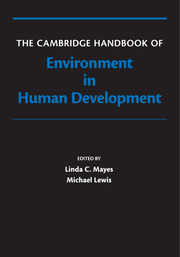Crossref Citations
This Book has been
cited by the following publications. This list is generated based on data provided by Crossref.
MIZOKAWA, Ai
and
KOMIYA, Asuka
2014.
SOCIAL ECOLOGY AND THEORY OF MIND.
PSYCHOLOGIA,
Vol. 57,
Issue. 2,
p.
133.
Hein, Sascha
Tan, Mei
Aljughaiman, Abdullah
and
Grigorenko, Elena L.
2014.
Characteristics of the home context for the nurturing of gifted children in Saudi Arabia.
High Ability Studies,
Vol. 25,
Issue. 1,
p.
23.
Fischmann, Tamara
2017.
Flucht, Migration und Trauma: Die Folgen für die nächste Generation.
p.
235.
Mohammed, Nisreen Yacoub
and
Samak, Yasser Abdelazim Abdelmawgoud
2017.
Spoil the Rod and Save the Child: Socioeconomic Predictors of Harsh Discipline by Parents, Egyptian Case Study.
Journal of Interpersonal Violence,
Vol. 32,
Issue. 11,
p.
1730.
Ozernov‐Palchik, Ola
Norton, Elizabeth S.
Wang, Yingying
Beach, Sara D.
Zuk, Jennifer
Wolf, Maryanne
Gabrieli, John D. E.
and
Gaab, Nadine
2019.
The relationship between socioeconomic status and white matter microstructure in pre‐reading children: A longitudinal investigation.
Human Brain Mapping,
Vol. 40,
Issue. 3,
p.
741.
Mukherjee, Sacchidananda
and
Badola, Shivani
2021.
Public Financing of Human Development in India: A Review.
Indian Journal of Human Development,
Vol. 15,
Issue. 1,
p.
62.
Yang, Sarah A.
and
Wild, Lauren G.
2022.
Associations Between Grandparent Involvement and Psychological Difficulties in Adolescents Facing Family Adversity.
Journal of Child and Family Studies,
Vol. 31,
Issue. 5,
p.
1489.
Richardson, Ken
2022.
Understanding Intelligence.
Giese, Sonja
Dawes, Andrew
Biersteker, Linda
Girdwood, Elizabeth
and
Henry, Junita
2023.
Using Data Tools and Systems to Drive Change in Early Childhood Education for Disadvantaged Children in South Africa.
Children,
Vol. 10,
Issue. 9,
p.
1470.
Endevelt-Shapira, Yaara
and
Feldman, Ruth
2023.
Mother–Infant Brain-to-Brain Synchrony Patterns Reflect Caregiving Profiles.
Biology,
Vol. 12,
Issue. 2,
p.
284.
Kuo, Chih Hsin
and
Kessler, Sharon
2024.
Intergenerational Transmission of Human Parenting Styles to Human–Dog Relationships.
Animals,
Vol. 14,
Issue. 7,
p.
1038.
Richards, Misty C.
Ferrario, Camila A.
Yan, Ying
and
McDonald, Nicole M.
2024.
The Impact of Postpartum Depression on the Early Mother-Infant Relationship during the COVID-19 Pandemic: Perception versus Reality.
International Journal of Environmental Research and Public Health,
Vol. 21,
Issue. 2,
p.
164.





